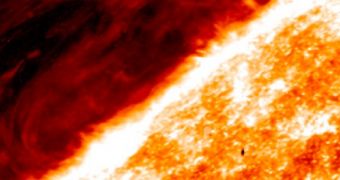Even though the NASA Interface Region Imaging Spectrograph (IRIS) space probe was launched less than half a year ago, its sensitive detectors are already producing results in their study of the solar interface, a little-understood layer in the lower portions of the Sun's atmosphere.
IRIS, which conducts studies in ultraviolet wavelengths, was boosted into space aboard a Pegasus XL delivery system from the Vandenberg Air Force Base, in California, on June 27, 2013. The 183-kilogram (403-pound) vehicle was manufactured by Lockheed Martin for the American space agency.
Its studies reveal an interesting degree of violence and complexity present in the solar interface, which lies between the solar surface and the corona. This layer is estimated to be between 4,800 and 9,600 kilometers (3,000 to 6,000 miles) thick, Space reports.
“We are seeing rich and unprecedented images of violent events in which gases are accelerated to very high velocities while being rapidly heated to hundreds of thousands of degrees. These types of observations present significant challenges to current theoretical models,” says Lockheed Martin expert Bart De Pontieu, the lead investigator on the mission.

 14 DAY TRIAL //
14 DAY TRIAL //